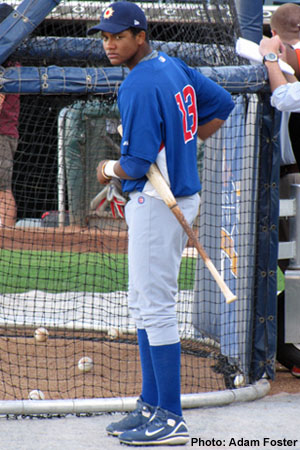
Editor's note: This article is brought to you by www.sportrabbit.com.
Defense is the easiest skill to scout in baseball.
Some players may dive, hustle and (grinder?) to win fans. But we know the good from the bad. And the pool of defensive data continues to expand.
Gone are the days of free agents without defensive value cashing in. Gone? Gone are the days of all bat, no D guys winning glove honors thanks to name recognition and clutch plays. Gone?
We know why teams didn’t shower you with offers last year Adam Dunn. And we knew that your premium defense would compensate for your raw bat Tim Beckham. Oh…wait.
Defense is the easiest hardest skill to scout in baseball.
It’s true. Even the untrained eye can occasionally recognize and appreciate good defense. But there are some substantial hurdles:
1. You need to see a guy for a series or two in order to get a good read on his defense.
2. Range can be lost over night as metabolisms slow and bodies grow.
I saw dozens of prospects multiple times this year. Even if I diligently arrived to the park early to watch infield and was 100-percent focused on the game, I didn’t always get a good read on a guy.
How can we learn more about minor league and amateur defense?
Watch thousands of games. Shape ourselves into an internet community scouting department…keep it simple. Unite.
Hands above replacement hands isn’t easy to quantify. Arm strength is translucent; accuracy isn’t. How about range?
I feel comfortable with the assumption that speed on the base paths gives a good indication of speed on defense. Yes, you can step into a shower of variables. But let’s keep it simple.
How many below-average runners can handle positions that require well-above-average range? The list is short.
Can we take good speed data and use it to open up some defensive debates? I think so.
Based on a speed information gathering effort Project Prospect took on at the Arizona Fall League, I have some comments to share:
Plus speed
Hector Gomez is the fastest player I’ve seen this season. He may be an 80 runner. And he undoubtedly has the speed to be an elite up-the-middle defender.
Dustin Ackley knows he’s in an organization that’s already rich in elite defensive outfielders. Based on what I've seen of him, he has the speed to play center, though. He's a plus runner (65-75).
Jose Tabata may be a 70 runner. While he’s built a little more like a rhinoceros than a gazelle, don’t write him off as a guy who’ll certainly be too slow to provide much defensive value.
Average speed
Grant Desme has average to slightly-above-average speed – a 55 runner when I saw him at the AFL. Could he be more than an adequate MLB center fielder?
Danny Espinosa would lose a foot race to all four of the players above. He’s an average runner – maybe slightly below (45-50). He needs to compensate for his relative lack of speed with other skills – fortunately he has an outstanding arm.
Ryan Kalish is a fringe-average runner (45). On a defensively minded team, he’s probably a corner outfielder.
Below-average speed
Carlos Triunfel was a below-average runner at the 2009 Arizona Fall League. Keep in mind that he was returning from a fractured tibia – he may not have been back to full speed – but he’s probably not an up-the-middle defender.
Starlin Castro is already a below-average runner, according to my data. And I know there are knowledgeable people who disagree with me, but I see his thighs growing over the next few years and him slowing down. Even a good arm, great instincts and the softest of soft hands wouldn’t be enough to allow a well-below-average runner to play an up-the-middle position.
Carlos Rivero is a well-below-average runner. He should not play shortstop.
Follow Adam Foster on Twitter.
